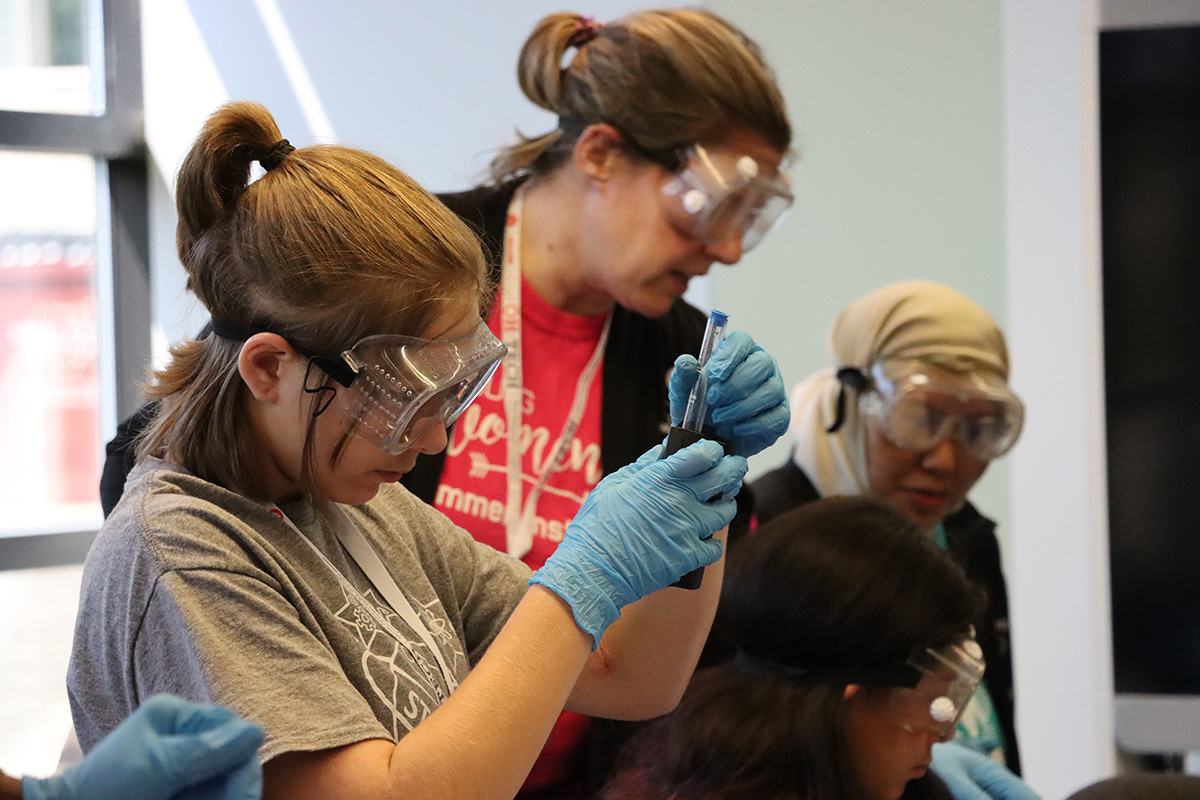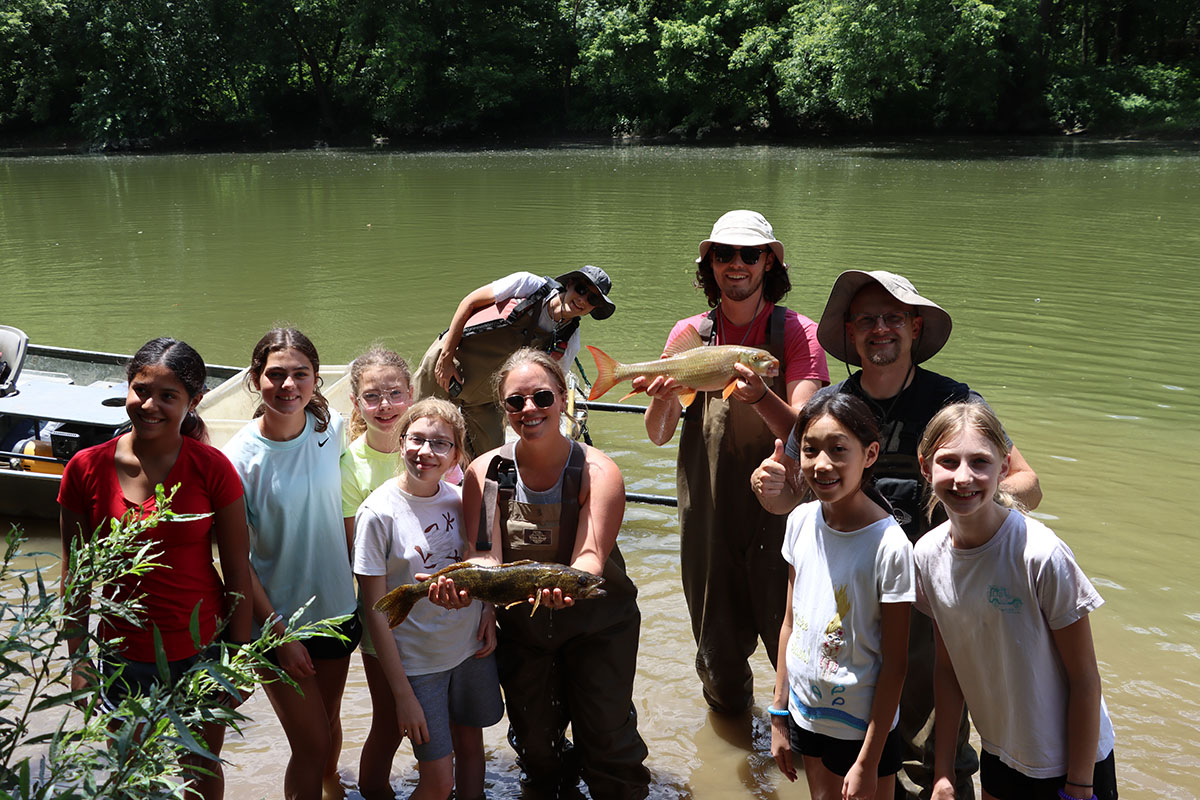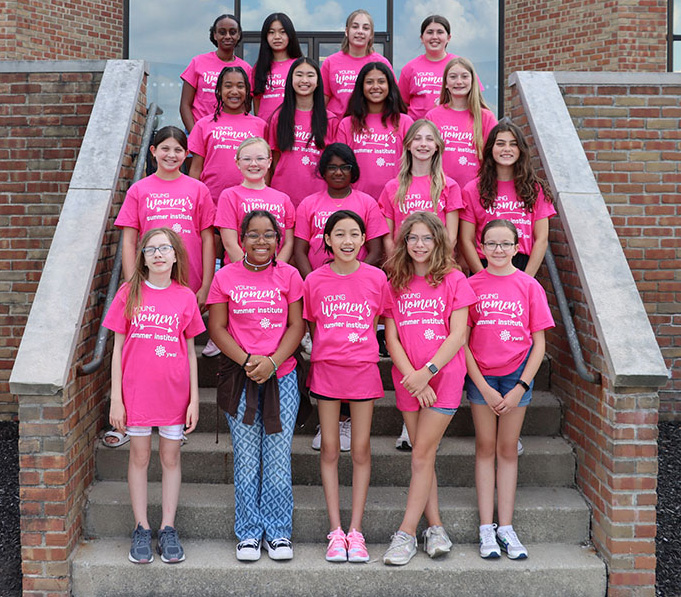Eighteen middle school girls from across the state attended the Ohio Supercomputer Center’s Young Women’s Summer Institute in July. Over the course of the one-week camp, the girls collected data from Battelle Darby Creek Metro Park and worked in groups to analyze water quality issues in Ohio’s watersheds.

The girls also observed scientific demonstrations, toured research facilities on The Ohio State University’s Columbus campus and participated in social activities in the evenings.
The camp was designed to bring middle school girls together for scientific exploration, to practice problem solving, learn data collection, discover how to formulate a hypothesis and meet women who work in different scientific fields, said Katharine Cahill, education and training specialist at the Ohio Supercomputer Center (OSC).
“It’s a space where the girls can explore and analyze, and also be comfortable asking questions and learning from each other,” Cahill said.
Data Collection and Projects
At Battelle Darby Creek the girls went into the water with their groups to collect wildlife, such as crawfish, to help them to analyze the level of pollution in the creek’s ecosystem. The girls also tested the water quality by conducting various chemical tests, including checking the creek’s pH.
Next the girls applied their new knowledge about watersheds to their own group projects. Each group was assigned an Ohio watershed, and the girls individually created their own hypothesis about a particular water quality issue. At the end of the week, the girls presented their group and individual work to their family and friends.
Whitney Cole, a seventh grade science teacher in the South-Western City School District, worked with the Upper Little Miami Watershed group.
“A lot of our watershed consisted of farmland, so the girls were really concerned with chemical compounds getting into the water,” Cole said. “The girls then investigated the riparian zone around the banks to see if any compounds that farmers might use for crops or animals were getting into the watershed.”
Cole said her favorite part of the week was watching the growth of her group's enthusiasm for what they were learning while working closely together.
“They can collaborate, but they can also investigate what they’re more concerned about, so it’s kind of like the best of both worlds,” Cole said.

Another group analyzed the East Fork Little Miami Watershed and was led by Patricia Fountain, a sixth, seventh and eighth grade science and Bible teacher at Columbus Adventist Academy.
Fountain said she really enjoyed going to the creek before starting the project because it taught the girls about the real-world application of science and how it connects to other subjects. Her group used their math skills when working with data, learned about the history of the watershed, and put it all together with their presentation that required language arts skills.
"I’m always looking for real-world examples to present to my students because students often tend to think of science as something they never see and that they’re not affected by it,” Fountain said.
Demonstrations and Tours
At the start of the week the girls were given a demonstration by Betty Lise Anderson, professor and associate chair of instruction in the Department of Electrical and Computer Engineering at Ohio State. Anderson showed the girls how to build a flashlight using cardboard, a battery, an LED light and a couple of wires.
While at the Metro Park, the girls also watched an electrofishing demonstration by the Ohio Environmental Protection Agency (EPA). The EPA traveled the creek in a boat that sent electrical pulses into the water to stun the fish long enough so they could collect them for later analysis of the water’s pollution levels. For the demonstration, the fish were placed in tanks so the girls could learn about the different species and touch and release the fish.
On Thursday, the girls went to Ohio State’s Byrd Polar and Climate Research Center where they learned about expeditions to collect rocks and ice cores from around the world to be analyzed for research purposes.
Before putting the finishing touches on their projects Friday, the girls went to Chadwick Arboretum & Learning Gardens at Ohio State, where they explored the gardens and learned about various local species of vegetation.
Evening Activities
In the evenings the girls participated in a variety of activities over the course of the week. Chaperone Betsy Fox strived to get the girls outside each night and provide them with a positive experience, as the camp was the first time being away from home for some of the girls.
“It’s a great way for the girls to have a week away, make new friends and see new things,” Fox said.
One night, the girls went to the Upper Arlington pool. Throughout the week they also played sand volleyball and other games, watched a movie, made their own scrapbooks and had a career night to hear from women who are working in STEM fields.
Fox, who was also a panelist speaking about research psychology, said career night helps the girls see all the different opportunities available to them and meet people who are working within the fields.
“It’s a great activity that helps them become comfortable with science and see how fun it can be,” Fox said. “It also shows them how they aren’t alone in their interest and that a lot of young women just like them want to do similar things.”
Outcomes
Even after only the first day, multiple girls stated in the program’s daily feedback questionnaire how they were “so excited,” the camp “has been great so far” and that “I am having so much fun and love this camp.”
Some felt that career night was beneficial because it showed them the wide variety of career paths they can pursue in science.

Cole said she feels that over the course of the week the girls learn a tremendous amount, such as computer and research skills, and have a lot of hands-on experience, especially at Darby Creek catching macroinvertebrates.
“It’s a well-rounded and organized camp,” Cole said. “I think the girls’ experiences during this journey will be amazing for them.”
Cahill said she hopes the girls leave the camp with a positive experience overall, make new friends and connect with one another about science.
“We want to make sure it’s fun and they enjoy it, as well as learn something important,” Cahill said.
(Students who are interested in applying for next year’s Young Women’s Summer Institute can find more information on the OSC website. Ohio residents currently in the sixth or seventh grades are eligible to apply for the camp. Applications typically open in January and close in April. Accepted students are notified in May.)
By Mary Kidwell
About OSC: The Ohio Supercomputer Center (OSC) addresses the rising computational demands of academic and industrial research communities by providing a robust shared infrastructure and proven expertise in advanced modeling, simulation and analysis. OSC empowers scientists with the services essential to making extraordinary discoveries and innovations, partners with businesses and industry to leverage computational science as a competitive force in the global knowledge economy and leads efforts to equip the workforce with the key technology skills required for 21st century jobs.